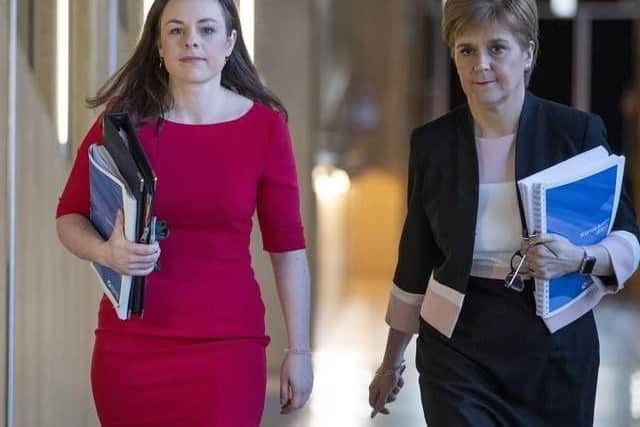Scottish spending review: What have we learned from Kate Forbes's announcement?
The finance secretary has decided the latter two – significant real-terms cuts and effectively begging the UK Government to spend more – is the only way to effectively tackle the £3.5 billion shortfall in Scotland’s public finances.
But what does the spending review tell us?
Scotland’s finances are dependent on the UK Government
Throughout both her statement and the spending review document itself, Ms Forbes repeatedly points at the volatility and uncertainty of the Scottish Government’s spending plans due to their dependence on the UK Government.
Advertisement
Hide AdAdvertisement
Hide AdThis is true – spending and taxation decisions made in Westminster directly increase or decrease the amount of money available to the SNP/Greens.
This is exacerbated when two governments are diametric opposites on how they want to get out of the cost-of-living crisis and their general approaches to the economy.


In reality this review is a plea from Scottish ministers for the UK Government to spend enough so they can get on with delivering their more expensive manifesto.
It is likely that will fall on deaf ears in Number 11.
In terms of independence – ministers have allocated £20 million to pay for a referendum next year – the SNP will use these cuts and this uncertainty as an argument in favour of Scotland seeking full fiscal autonomy.
But that opens the door for those who point at official figures, which show Scotland is a net beneficiary from the union.
Expect, in any case, these arguments around fiscal powers taking centre stage during any referendum campaign.
Justice and local government lose out, but pain felt across the board
More than half of the spending portfolios within the review will see real-terms cuts or worse to their budget.
But nowhere appears harder hit than those involved in the justice sector, with only police and fire service pensions seeing an increase in funding over the next four years.
Advertisement
Hide AdAdvertisement
Hide AdThe Crown Office will see its budget frozen, as will the budget for legal aid, the Scottish Prison Service, the Scottish Police Authority and the Scottish Fire and Rescue Service.
Scottish Courts and Tribunals, which is facing working through a courts backlog that could take five years to clear, will have to do so with a budget frozen at £100m a year.
Funding for tourism and enterprise will also suffer, with a cut to their budgets of £23m over five years.
Higher education and universities will also feel the pain, with the Scottish Funding Council, Scotland’s central funding body for higher and further education, seeing its budget frozen at £1.5bn.
The main winners are those working on climate change, which sees an increase of half a billion, and health, which continues to be prioritised by the Government alongside the development of the National Care Service.
Public sector worker? Brace yourself
Those working in the public sector and hoping for an inflation-busting pay rise will likely be hoping they can simply hold on to their jobs by 2026.
Ms Forbes’ plan for the public sector – partially required due to decreasing headcounts sparked by Westminster cuts to the civil service – has seen her commit to returning to pre-Covid levels for the civil service workforce over the next four years.
There is also an ominous warning around the need for a “balance” and the need to “deliver sustainable settlements”, or risk the potential to “increasingly squeeze our capacity to maintain services and increase rates of pay”.
Advertisement
Hide AdAdvertisement
Hide AdThis suggests around 30,000 employees across Scotland’s public sector may be at risk as the civil service jargon of efficiencies, capacity and sustainability are trotted out in coming years.
This cut may also come alongside pay freezes for higher earners.
The finance secretary has committed to keeping the overall public sector pay bill at around 2022/23 levels, and will hope this will mostly be achieved through reducing the overall workforce.
If she succeeds, "fair and affordable pay increases that support the lowest paid” will follow, the review states.
Another cost-saver is likely to come from the Scottish Government’s own property portfolio and wider estate, with the review committing to reducing the overall public sector footprint.
This will see more “co-location” and “interoperability” across Government buildings, and potentially the closure of some offices.
What about tax?
Taxation levels are decided each year at the Scottish Budget, and the spending review assumes no change to the tax levels until 2026.
That, however, feels highly unlikely to be the reality given Chancellor Rishi Sunak’s pledge to cut income tax before the next general election.
Advertisement
Hide AdAdvertisement
Hide AdIt may be the Scottish Government would view raising income tax as too politically risky against that backdrop, but there are other areas where money could be found.
For example, when discussing non-domestic rates – the tax paid for business premises – there is an ominous mention of a potential “increase in the poundage” to be required.
This is not exactly music to the ears of high street businesses.
The review also talks of public bodies potentially finding ways to “recover more of their costs” and, of course, there is the potential introduction of the tourist tax and (officially the Visitor Levy) and the Workplace Parking Levy.
That is all before any further potential rises to or reform of council tax are mentioned.
Want to hear more from The Scotsman's politics team? Check out the latest episode of our political podcast, The Steamie.
It's available wherever you get your podcasts, including Apple Podcasts and Spotify.
Comments
Want to join the conversation? Please or to comment on this article.

